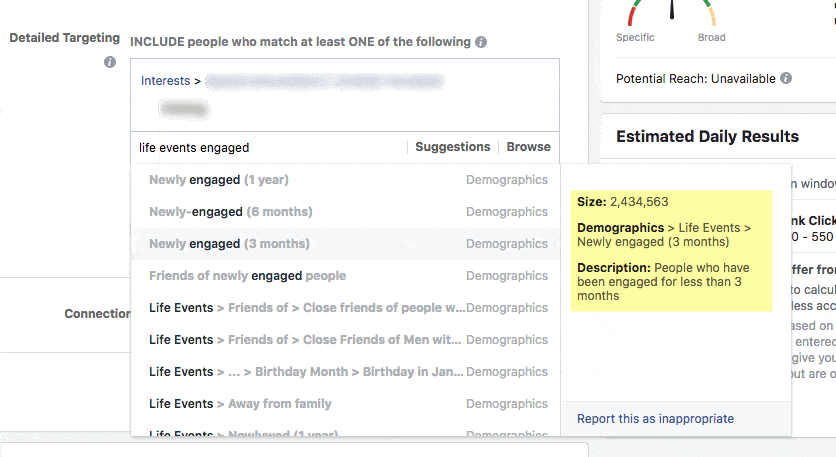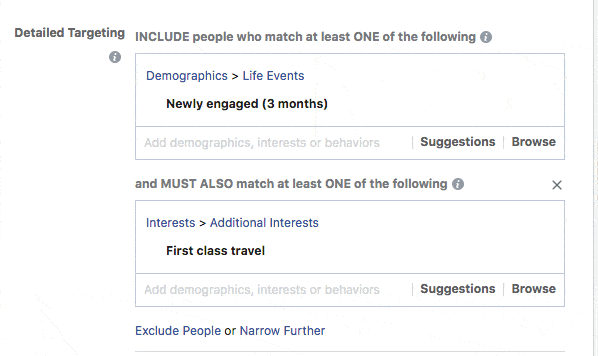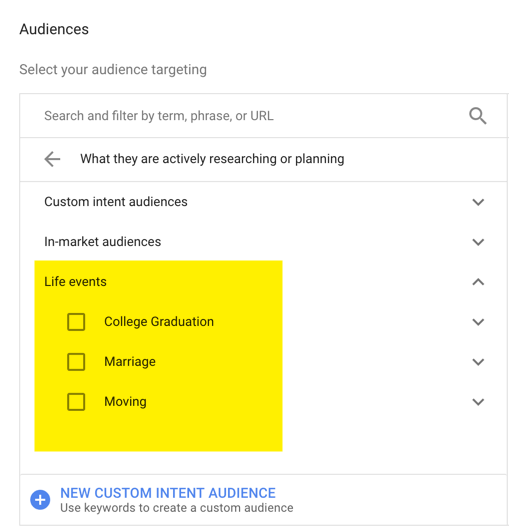An individual’s life events will no doubt trigger actions that marketers deem valuable: content consumption or purchase decisions.
With each life event, there are expected behaviors and purchases that coincide with that event.
For example, an upcoming wedding will likely be in the market to work with a reception hall. Sometimes less obvious, a newly married couple may have to combine their residences, and then be in the market for a moving company.
Life event targeting is also great for local businesses.
Consumers experiencing a life event are further down the sales funnel and closer to the purchase. They will usually have a timeline involved in the purchase – for example, a deadline for a wedding or starting college.
Advertisers are interested in both major and minor life events to reach audiences at the perfect time.
Common life events that advertisers are interested in:
- Starting/graduating college
- Buying a home/moving
- Engagement
- Marriage
- Births
- Retirement
Several PPC and social ads channel offer options for life event targeting lists, or other close targeting methods, such as intent or in-market.
Facebook has a life event feature in which users create a special post declaring the life event and details like the date, description, and even photos.
To check it out, go to your name on your personal page on the top left, select “about”, you will find out how to add life events to your personal Facebook page.
This will give you an idea more about the life event posts from the user experience.

We can see more detailed life events than other channels, such as engagement and even how recent the engagement is. This level of information can be very powerful information for advertisers.

These life events, along with layering them with other targeting options, can help laser focus the campaign and messages to that audience.
For example, we can reach an audience that has been engaged for three months, and also has an interest in first-class travel. What a great opportunity for a local travel agency to promote luxury honeymoons/vacations.

Google Ads
Life event targeting was released earlier this year and is only available in Gmail and YouTube targeted campaigns.
Only three categories of events are available:
- College graduation.
- Marriage.
- Moving.
This life event targeting can also be layered with additional audience targeting.

Even though this is limited, it seems promising for the future if it is expanded and rolled out to Google.com search campaigns.
To create audience lists, Google looks at the user’s behavior on the websites they visit, videos they watch, content they consume and much more.
If we can’t access a list that is specifically “life events”, we can create our own list. We can take common interests associated with a life event and create a custom audience.
Custom Intent Audiences (Auto Created)
Google creates custom segments based on the existing campaigns in the account.
Machine learning links up the behavior and interests of users with the account and creates a custom list that will be refreshed and improved over time.
For example, if you are advertising new cars, Google may recommend a new audience for “car dealerships” or “car accessories”.
Custom Intent Audiences
Created by the advertiser, this is an opportunity to create your own life event targeting.
Identify URLs that the user is likely to visit along with keywords describing and complementary to the life event.

Google Ads will also recommend in-market audiences, which are composed of users who have exhibited behavior they are ready to buy.
While an in-market list for “apparel” would be tricky to tie back to a life event, the examples in the screenshot are pretty clearly linking back to a life event:
- Wedding photography
- Wedding ceremony ideas
- Wedding planning
Now, we can target our life event!
Bing Ads
Bing Ads is not offering life event targeting at this time, but we have a great runner-up option we mentioned earlier: in-market audiences.
Released earlier this year, advertisers can quickly reach consumers who are ready to buy.
Using artificial intelligence, Bing Ads predicts and identifies audience segments in 170 in-market audiences for search campaigns across many popular industries.
A few examples of the detail of the audiences that can be targeted include:
- Apparel & Accessories/Formal Wear/Bridal Wear
- Baby & Children’s Products/Baby & Children’s Apparel/Baby & Toddler Apparel
- Financial Services/Credit & Lending/Mortgage/Home Purchase Loans
- Financial Services/Financial Planning/Estate Planning
- Jobs & Education/Jobs & Careers/Job Listings
Some of the topics above can certainly be associated with life event targeting, like “bridal wear” and “home purchase loans”.
Advertisers can identify their unique topics most likely to be associated with life event targeting, knowing the users on the list have been identified in the market to purchase.

In the simple example above, an advertiser could reach a qualified segment whose online behavior is in line with someone house shopping.
Bing Ads recommends getting started to:
“Associate the In-market Audiences to existing top-performing ad groups as ‘bid only’ with 20 percent bid adjustment and monitor for 2 weeks. This allows you to quickly compare the performance of ad groups using In-market Audiences against those not using them.”
Pinterest is one the most under-used ad platforms and ripe for life event targeting.
With 200 million monthly users, mostly women are there to research and plan.
According to Pinterest, “In our study, Pins that referenced seasonal moments or special occasions drove 10x higher aided awareness.”
What a great place to implement a life event targeting strategy!
Pinterest allows detailed targeting by interest, keyword, retargeting, and other simple settings. Searching through the available 6,468 interests, advertisers get an instant estimate on the potential audience.
Want to target new mothers? In this example, advertisers can reach 7.58 million to 10.3 million U.S. Pinterest users.

Conclusion
With life event targeting advertisers should think about each life event and the expected behaviors and purchases that coincide with that event.
Advertisers tend to think of interests and audiences directly associated with their product, rather than the person.
Targeting in a way that is more personal can not only yield better ROI, but build a relationship and loyalty with new customers by meeting their needs at that moment.
More Paid Search Resources:
- 5 Easy Ways to Improve Your PPC Campaigns with Audiences
- 4 Powerful Facebook Ads Targeting Options
- What Is Predictive Advertising & Why Do You Need It?
Image Credits
All screenshots taken by author, August 2018


